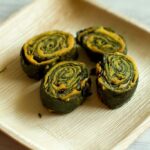What is Patrode?
Patrode is a Himachali seasonal speciality made during the end of the monsoon season when the arbi leaves can be found in abundance.
Patrode has been identified as one of the ‘traditional food recipes from the AYUSH system of medicine’ by the Union Ministry of AYUSH.
It is also prepared as one of the delicacies cooked to mark the celebrations of Sankranti which falls each year on September 16.
Patrode is one of the famous tea-time snacks in the hills of Himachal Pradesh, which you can also eat with roti at dinner. So it is an anytime meal.
It is said, that the word ‘patrode’ is derived from two words – ‘patra’ and ‘vade’ where patra means leaf and vade means dumpling.
Originally, Patrodo/Patra/Patrodu is considered to be a vegetarian dish from the Western coast (Tulunad) in India.
It is also adopted in the Himachal Pradesh Cuisine and that of Gujarat, UP & Bihar and some other names in other parts of India.
What are Patrode made with?
Patrode is made from arbi ke patte or Colocasia leaves. Arbi is also known as arvi, kachhu or kachalu in Hindi and Colocasia in English.
It is also known as घण्डयाली (ghandyali) in Himachali language.
How are Patrode made?
Patrode is made by using besan (gram flour) and Colocasia leaves.
The leaves are wrapped around the mixture of besan and spices, made into tiny cylinders or rolls, steamed and cut into slices which can then be deep or shallow-fried.
How is Patrode used?
Patrode is a homemade snack, which can be consumed any time of the day with any meal of the day accompanied by a glass of buttermilk or a bowl of curd due to the fiery, spicy and hot temperament of the leaves.
